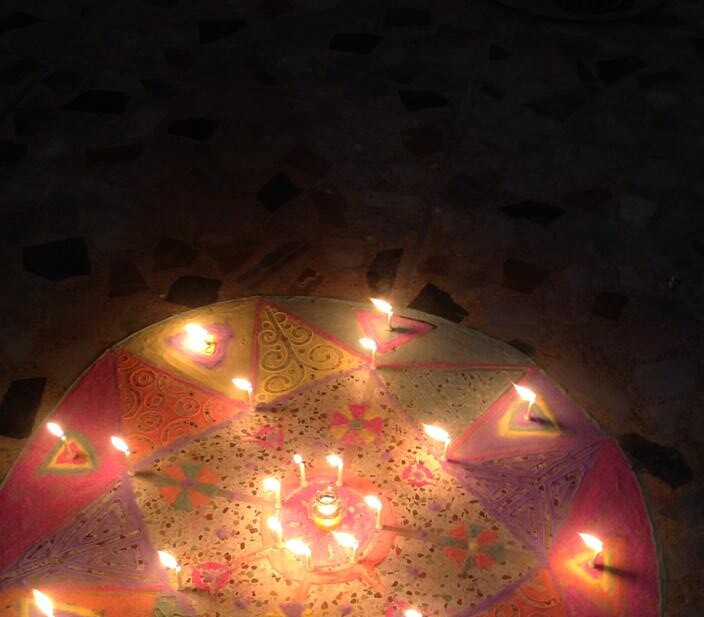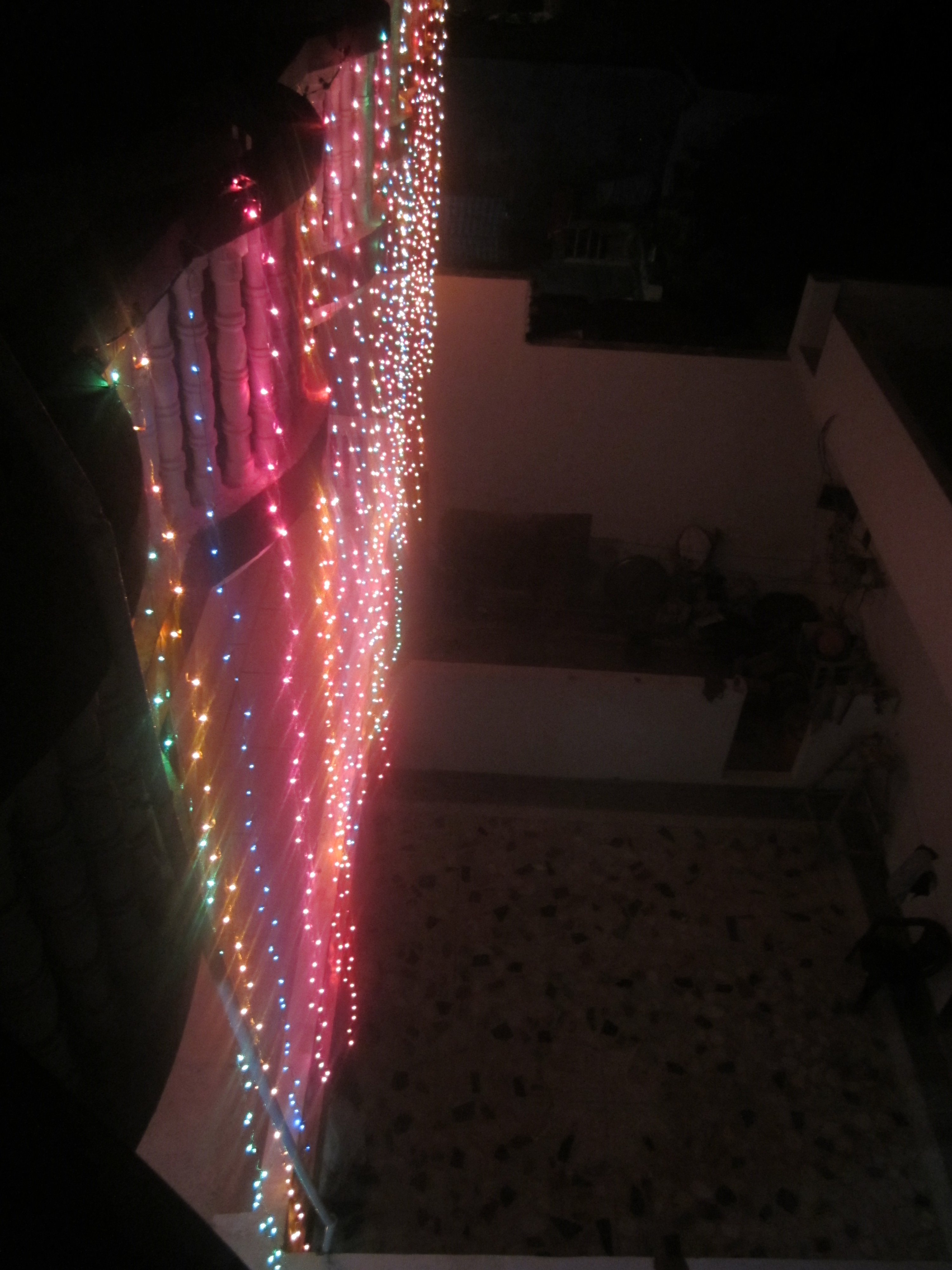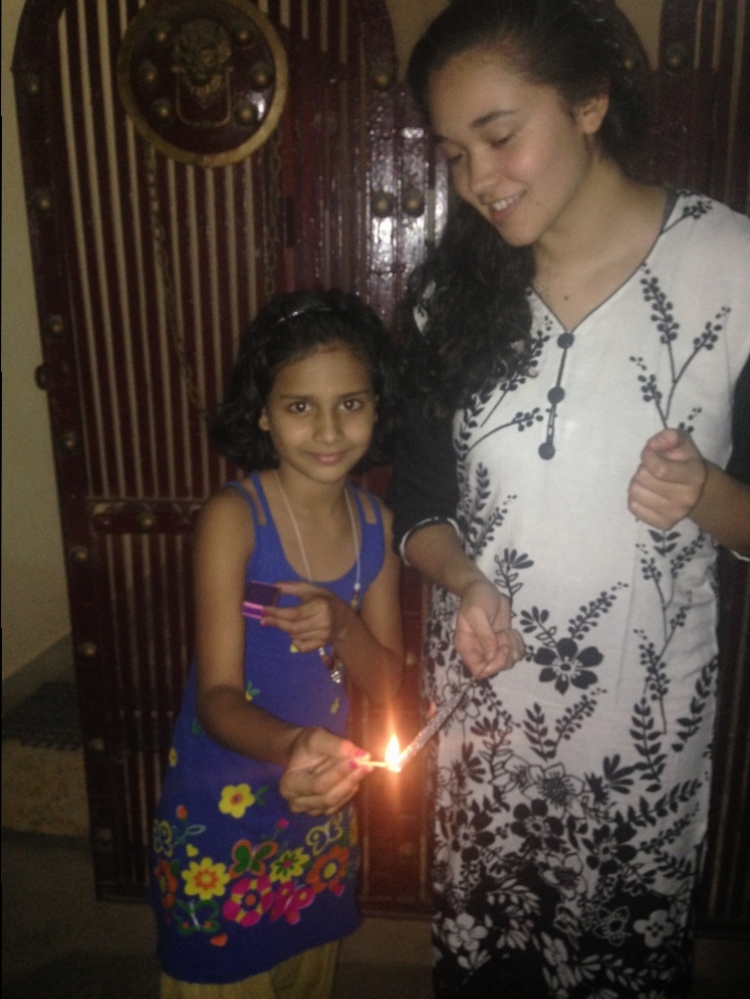
by Isabella Hernandez
Hello, once again! I hope to just give a brief update on my current volunteer work and recent big experiences so far in India. I have now settled into daily life and am living with a Host family in Haryana State, in the northern part of the country, a few hours from the Delhi airport. During the past month, I have been working hard teaching chemistry, but because it is the Diwali holiday season, I have also been learning a lot about Indian culture and Hindu religion, and, I have to say, it’s having a profound effect on me.
The Teaching Part
So, for the past month I have been working as a volunteer biology and chemistry teacher at Acme International School in Sohna, India. This school is a rural private school and is run by my host family’s grandfather, Chairman Rampat Yadav. It has been quite a challenge learning how to teach chemistry to students whose first language is not English. Most of the time my students have to remind me to speak slowly during lecture. It is funny honestly, when I first began this journey I was set on teaching English while in India. I never in a million years imagined being a science teacher to students only a few years younger than myself.
Having this amazing experience has allowed me to keep up with my past studies and refreshed my memory of my Biology and Chemistry classes. It also has allowed me to increase my capability to study on a deeper level. Who knew studying was all about ones’ mind set? Studying for myself is drudgery, and my eyes usually become heavy, and my mind wonders how nice it would be to take a nap. In contrast, now that I am studying for the purpose to teach the material, I have found that my mind is ten times more engaged. This new purpose somehow allows the words on the page to stop “flowing into one ear and out the other”: Rather it sticks and is actively filed away for class time use.
Ask me anything now, and I have got it down!
Diwali
Currently in India it is the time of year where elections, festivals, wedding parties, and holidays happen. So, I have been having many short hiatuses during my teaching period. However, I am loving being able to see India at such a happy and festive time. It is a great combination of dusty books and reading, then suddenly followed by bursting firecrackers and laughter. I am constantly learning the most amazing things about the Hindu religion and ways of life here in India. Since I live in a small village outside of Sohna, I have been able to experience a wide range of lifestyles outside of the American middle class I am accustomed to.
Just a few weeks ago I was able to celebrate the most exciting holiday in India, Diwali. Diwali means the “festival of lights” and is an ancient Hindu festival celebrated in fall celebrating victory of good (light) over evil (darkness). All of the preparations and rituals last five days in total, but only one day is called Diwali.
Five Days of Ritual/ Preparations
Day One: Dhantera – On this day the family asked for the blessings of Lakshmi, the Goddess of wealth. Everyone bathed and changed into fresh new clothes. The house and courtyard were cleaned by my host mother and servant. This was done in preparation for the lights to be hung and set up around the home. My host sister and I spent time rolling cotton to burn in the oil lamps during the next evening. This process was quite time consuming and ended up giving me chapped red hands. By the end of the day my host brother and his cousin hung the string lights from the top floor of the home. It reminded me of Christmas back home in the US. It was an added bonus that my room happened to be located right under the lights. After getting ready for the night I was able to enjoy the pleasant homey glow of the lights cascading in through my bedroom window.

Day Two: Choti Diwali – This celebratory day is a smaller scale Diwali. We finished the decorations such as rangoli in the courtyard and setting up the lit oil candles. In the evening the smaller Hindu boys in the village came outside to light some of the smaller firecrackers.
On this day I helped my host family prepare gifts for the family friends and relatives. Afterwards I began helping my host sister make the rangoli in the courtyard. Rangoli is colorful sand art placed in the center of the home as a welcome and also to bring good luck. The most exciting part of preparations was making the rangoli! I had so much fun placing the colored sand in the middle of the family courtyard area. In the beginning my host sister was going to complete the Rangoli with my help, but after time the task was handed over to me for the rest of the evening. While I worked on completing this design my host sister prepared for her trek through the village with all of the other girls in the community. This is a tradition each year that is done to light all of the holy places in the village area.
The few hours I spent making my very first rangoli was my favorite part of preparations. At first I was having a big problem figuring out how to grasp the colored sand in my hand so that it would pour out smoothly. However, I was really getting the hang of it by the end; my host sister later told me it was the best rangoli they had ever had. She guarded it for the rest of the four days from the courtyards shuffling feet. Even the neighbors’ young girls came over to see my design. I felt so glad to have given the family a nice decoration to welcome and bring good luck throughout the celebration week.

Day Three: Diwali – For this day the goddess Lakshmi is worshiped for blessings of wealth and prosperity. The grandchildren and I visited the shrine of their ancestors. Lit oil candles and prayed to their ancestors. The Hindu homes and courtyards were once again lit up once again in the evening and firecrackers burned throughout the night until early morning. A firecracker flew into my balcony that night during the celebrations; thank goodness I had the sense to close the door before the celebrations began that evening.
Day Four: Govardhan Puja. On this night the older women in the village shaped a mound of cow manure into the figure of a man and decorated it with flour in the center of the Hindu section of our village. This mound represented the Govardhan Mountain that Lord Krishna raised to protect the people from a terrible storm in one of the Hindu’s religious stories. Later that night the men of the village gathered around the mound and placed lit candles in the body and sang a chant revolving around the mound in unison. At the ritual’s conclusion, the married women came and poured milk over the stomach of the man in blessing.

Day Five: Bhai Duj – This day is entirely dedicated to sisters. The lord of death visited his sister on this day, and so now brothers visit sisters on this day to receive puja (prayer). The sisters perform puja to seek blessings for their brothers, and, in turn, brothers give presents to their sisters as a token of love. There was not anything in particular that happened at the home on this day. It was a day of rest and visitations from many guests. The cousins and brothers came and visited my host sister and me, keeping us in good company for most of the day until evening.
During these five days I was even given the chance to sit in on prayer. This was perhaps the best cultural experience of my time here so far. The whole family came into the prayer room barefoot where the shrine was set up and sat cross-legged while the grandfather chanted prayers for Diwali puja. Bare feet are necessary because shoes are seen as dirty, and, of course, they do not want to make the house of God or his holy places dirty.
After prayer we had a red mark placed between our eyebrows. It is my understanding that Hindus believe this to be the location of the third eye, or spiritual wisdom, and it is called Tilak. Lastly, we ate a blessed offering of puffed rice grains and sugar cubes. The rest of the offering is distributed to various people in the community. One is never to refuse being offered this blessed food, and so, as each family in the village completed prayer, one could see many people walking around, distributing the rest of the blessed food.
I am truly glad to have been able to experience such an important five-day celebration period in India; it is an experience that will definitely stay with me for life. I was able to gain a broader understanding of Hindu religion, rituals, and family relationships. I see my host family cherishing things and practicing their religion much more than many Christians in America do during Christmas or Easter. We don’t all gather around the Christmas tree telling bible stories and listening to the birth of baby Jesus. And perhaps this view of mine is only because my family never did this during the Christmas time celebrations. Somehow, our Christian celebrations have become very superficial and about how many gifts are bought and who acquired the latest in technology or fashion.
In comparison between India and America, I somehow sense that there is so much more connection between the daily life of a Hindu and their religious nature than with my Christian community back in the United States. I have yet to witness a lax Hindu, the way in which the religion is structured doesn’t allow for laxity. Maybe this is due to the visibility of religion. An example would be the red prayer mark, it is like a beacon saying “I prayed today”: In my faith no such thing is present. India has taught me a vast amount about the importance of keeping in touch with one’s family and how the relationships should be cultivated and maintained. Family is so important here as well as the religious ties one has with God. There seems to be an inner peace and comfort that Hindus have with their religion, something I have not ever really been exposed to. Confusion in what is to be expected of them and God’s place in their world is not something that seems to be very prevalent.
In a sense, then, I am refreshed by the peaceful nature of Hindus. Somehow, India has transferred to me a sense of calmness. I wonder how much more I will learn during my next five months in India. I can already feel the changes working within me, the fast and stressful ways I am familiar with are slowly slipping away from me. This whole month, not just Diwali, has given me a brand new “fresh” look on the world and how I am wanting to live my life.
Best Wishes and Happy Belated Diwali Everyone!

